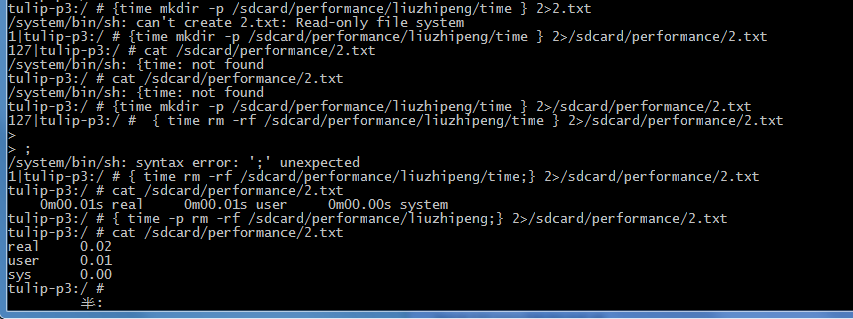
注意: 命令后面一定要有分号;
http://codingstandards.iteye.com/blog/798788
用途说明
time命令常用于测量一个命令的运行时间,注意不是用来显示和修改系统时间的(这是date命令干的事情)。但是今天我通过查看time命令的手册页,发现它能做的不仅仅是测量运行时间,还可以测量内存、I/O等的使用情况,手册页上的说法是time a simple command or give resource usage,其中time一词我认为它应该是测量或测定的意思,并不单指时间。一个程序在运行时使用的系统资源通常包括CPU、Memory和I/O等,其中CPU资源的统计包括实际使用时间(real time)、用户态使用时间(the process spent in user mode)、内核态使用时间(the process spent in kernel mode)。但是简单的使用time命令并不能得到内存和I/O的统计数据,请看后文慢慢道来。
常用参数
time命令最常用的使用方式就是在其后面直接跟上命令和参数:
time <command> [<arguments...>]
在命令执行完成之后就会打印出CPU的使用情况:
real 0m5.064s <== 实际使用时间(real time)
user 0m0.020s <== 用户态使用时间(the process spent in user mode)
sys 0m0.040s <== 内核态使用时间(the process spent in kernel mode)
time命令跟上-p参数可以只打印时间数值(秒数),不打印单位。
使用示例
示例一 统计运行时间
[root@web186 root]# time find . -name "mysql.sh"
./work186/sms/bin/mysql.sh
./work186/sms/src/scripts/mysql.sh
./work186/sms/src/scripts1/mysql.sh
./work186/sms1/bin/mysql.sh
./work186/sms1/src/scripts/mysql.sh
./temp/sms/bin/mysql.sh
./temp/sms/src/scripts/mysql.sh
real 0m14.837s
user 0m0.030s
sys 0m0.120s
[root@web186 root]#
注:real远大于user加上sys,因为find需要遍历各个目录,需要大量的I/O操作,而磁盘I/O通常是最慢的环节,因此大部分时间find进程都在等待磁盘I/O完成。
[root@web186 root]# time find . -name "mysql.sh"
./work186/sms/bin/mysql.sh
./work186/sms/src/scripts/mysql.sh
./work186/sms/src/scripts1/mysql.sh
./work186/sms1/bin/mysql.sh
./work186/sms1/src/scripts/mysql.sh
./temp/sms/bin/mysql.sh
./temp/sms/src/scripts/mysql.sh
real 0m0.230s
user 0m0.040s
sys 0m0.030s
注:再次运行的时候,发现real time变得很小了,应该是操作系统将刚才操作过的一些文件缓存了的缘故,因而大大减少了磁盘I/O。
[root@web186 root]# time -p find . -name "mysql.sh"
./work186/sms/bin/mysql.sh
./work186/sms/src/scripts/mysql.sh
./work186/sms/src/scripts1/mysql.sh
./work186/sms1/bin/mysql.sh
./work186/sms1/src/scripts/mysql.sh
./temp/sms/bin/mysql.sh
./temp/sms/src/scripts/mysql.sh
real 0.15
user 0.04
sys 0.03
注:使用-p参数时,直接打印所需时间的数值,单位为秒,而不是更友好的格式,包括分钟、秒钟的显示方式。
[root@web186 root]#
示例二 Linux系统中time命令其实不止一个
看过手册页的朋友,会发现有个-f参数可以来指定统计信息的输出格式,我们也来试一下。
[root@web186 root]# time -f "real %f
user %f
sys %f
" find . -name "mysql.sh"
-bash: -f: command not found
real 0m0.024s
user 0m0.000s
sys 0m0.000s
怪哉,不灵啊。使用type -a来看一下。使用这个shell内建命令经常会有意想不到的发现。
[root@web186 root]# type -a time
time is a shell keyword
time is /usr/bin/time
注:通过这条命令我们可以发现我们常用的time其实是一个Shell关键字,还有一个外部命令/usr/bin/time,它有何不同呢?
[root@web186 root]# /usr/bin/time
Usage: /usr/bin/time [-apvV] [-f format] [-o file] [--append] [--verbose]
[--portability] [--format=format] [--output=file] [--version]
[--help] command [arg...]
注:外部命令/usr/bin/time功能更强大,下面来尝试一下。
[root@web186 root]# /usr/bin/time find . -name "mysql.sh"
./work186/sms/bin/mysql.sh
./work186/sms/src/scripts/mysql.sh
./work186/sms/src/scripts1/mysql.sh
./work186/sms1/bin/mysql.sh
./work186/sms1/src/scripts/mysql.sh
./temp/sms/bin/mysql.sh
./temp/sms/src/scripts/mysql.sh
0.03user 0.04system 0:00.12elapsed 55%CPU (0avgtext+0avgdata 0maxresident)k
0inputs+0outputs (154major+63minor)pagefaults 0swaps
注:注意后面两行,打印了很多信息,但看不太清楚。它有一个参数-v,可以打印得更清楚些。
[root@web186 root]# /usr/bin/time -v find . -name "mysql.sh"
./work186/sms/bin/mysql.sh
./work186/sms/src/scripts/mysql.sh
./work186/sms/src/scripts1/mysql.sh
./work186/sms1/bin/mysql.sh
./work186/sms1/src/scripts/mysql.sh
./temp/sms/bin/mysql.sh
./temp/sms/src/scripts/mysql.sh
Command being timed: "find . -name mysql.sh"
User time (seconds): 0.03
System time (seconds): 0.05
Percent of CPU this job got: 47%
Elapsed (wall clock) time (h:mm:ss or m:ss): 0:00.17
Average shared text size (kbytes): 0
Average unshared data size (kbytes): 0
Average stack size (kbytes): 0
Average total size (kbytes): 0
Maximum resident set size (kbytes): 0
Average resident set size (kbytes): 0
Major (requiring I/O) page faults: 153
Minor (reclaiming a frame) page faults: 64
Voluntary context switches: 0
Involuntary context switches: 0
Swaps: 0
File system inputs: 0
File system outputs: 0
Socket messages sent: 0
Socket messages received: 0
Signals delivered: 0
Page size (bytes): 4096
Exit status: 0
[root@web186 root]#
尝试完这个之后,我看了一下Google搜索的结果,发现有位大虾早已发现了这个秘密,见相关资料【1】。
示例三 解决time命令输出信息的重定向问题
time命令的输出信息是打印在标准错误输出上的, 我们通过一个简单的尝试来验证一下。
[root@web186 root]# time find . -name "mysql.sh" >1.txt
real 0m0.081s
user 0m0.060s
sys 0m0.020s
[root@web186 root]# time find . -name "mysql.sh" 2>2.txt
./work186/sms/bin/mysql.sh
./work186/sms/src/scripts/mysql.sh
./work186/sms/src/scripts1/mysql.sh
./work186/sms1/bin/mysql.sh
./work186/sms1/src/scripts/mysql.sh
./temp/sms/bin/mysql.sh
./temp/sms/src/scripts/mysql.sh
real 0m0.068s
user 0m0.040s
sys 0m0.030s
通过上面的尝试,发现无法将time的输出信息重定向到文件里面,为什么?因为time是shell的关键字,shell做了特殊处理,它会把time命令后面的命令行作为一个整体来进行处理,在重定向时,实际上是针对后面的命令来的,time命令本身的输出并不会被重定向的。那现在怎么办呢?网上提供了两种解决方法【2,3】,我们一一尝试一下。
第一种解决方法,就是将time命令和将要执行的命令行放到一个shell代码块中,也就是一对大括号中,要注意空格和分号的使用。
[root@web186 root]# {time find . -name "mysql.sh"} 2>2.txt
好像成功了。慢,看一下对不对。
[root@web186 root]# cat 2.txt
-bash: {time: command not found
原来bash把 {time 作为一个整体来处理了,前后都加上空格试试。
[root@web186 root]# { time find . -name "mysql.sh" } 2>2.txt
> Ctrl+C
这次Bash认为命令都没有输入完成,少了分号。因为Bash认为后面的 } 是find命令的参数。
[root@web186 root]# { time find . -name "mysql.sh"; } 2>2.txt
./work186/sms/bin/mysql.sh
./work186/sms/src/scripts/mysql.sh
./work186/sms/src/scripts1/mysql.sh
./work186/sms1/bin/mysql.sh
./work186/sms1/src/scripts/mysql.sh
./temp/sms/bin/mysql.sh
./temp/sms/src/scripts/mysql.sh
[root@web186 root]# cat 2.txt
real 0m0.068s
user 0m0.030s
sys 0m0.040s
第一种方式的尝试成功了,总结起来就是 { time command-line; } 2>file 注意分隔符的使用。
另外一种方式就是使用子Shell的方式,如下所示:
[root@web186 root]# (time find . -name "mysql.sh") 2>2.txt
./work186/sms/bin/mysql.sh
./work186/sms/src/scripts/mysql.sh
./work186/sms/src/scripts1/mysql.sh
./work186/sms1/bin/mysql.sh
./work186/sms1/src/scripts/mysql.sh
./temp/sms/bin/mysql.sh
./temp/sms/src/scripts/mysql.sh
[root@web186 root]# cat 2.txt
real 0m0.083s
user 0m0.040s
sys 0m0.020s
[root@web186 root]#
第二种方式的尝试也成功了,总结起来就是 (time command-line) 2>file 这里time紧贴着小括号(也可以的,命令行结束也不必带分号。当然最好还是用第一种方式,毕竟启动一个子shell是要多占些资源的。
问题思考
1. 为什么执行find命令的多次时间统计差别很大,一次实际时间需要12秒,另外几次却不足1秒?